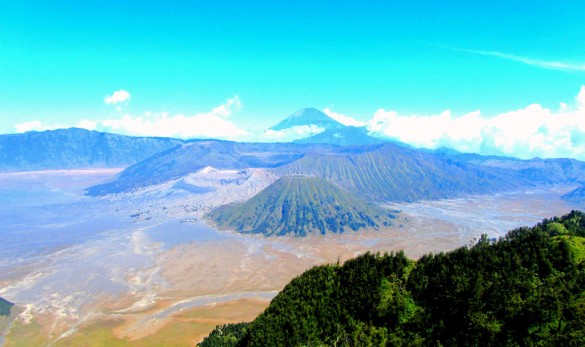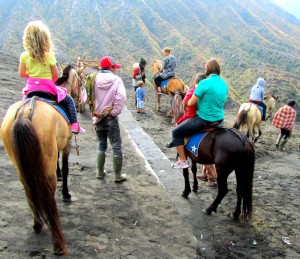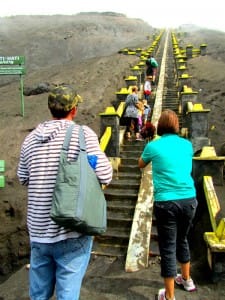
Mount Bromo (Gunung Bromo), an active volcano two hours’ drive east of Surabaya, East Java, is by far the most accessible volcano in the region. Still active and occasionally spewing ash and smoke over the area, it is set on an eerie plain known as the Sea of Sand, a caldera on which four volcanic cones have emerged. A protected nature reserve since 1919, this area is home to the Hindu Tengger people, who, the story has it, fled into the highlands to escape the encroachment of Islam in the 16th century.
Most visitors approach Bromo via Probolinggo to the east of Bromo, but we take a shorter route via Pasuruan, in part because it is closer, but also because it is more scenic and less touristic. The route takes us through highland Tengger villages with outstanding views down on the valleys that fall below the mountain slopes.
First stop is to an elaborate village market at Pasrepan. Here, goods are brought in from the surrounding countryside, everything from vegetables, chickens and goats, to farm implements, fish and tobacco.
Few visitors come this way so we attract a good deal of attention, but certainly in a friendly way. The produce here is about the best there is: cabbages, cauliflowers, carrots, potatoes, tomatoes abound, all grown on the fertile slopes of this volcanic region, and they look amazingly fresh and worth buying. Buyers come in from far afield to purchase here, supplying restaurants and city markets in the area.
The road winds on up at a serious degree of incline, but the asphalt surface is good and it is only the twists and turns that may be hazardous. We stop at points along the way where we can gaze down into beautifully cultivated valleys, where terracing utilizes every possible inch for planting. The angle at which the farmers must work looks excruciating. The Tenggerese live in simple wooden dwellings that perch themselves on the mountainsides, sitting precariously above the road. These people are short, with ruddy complexions and sinewy limbs. Sarongs are draped over their shoulders as a kind of shawl against the cold.
Eventually we reach the entrance to the Bromo Tengger Semeru National Park where we transfer to hardtop jeeps (all Toyota Land Cruisers from the 70s) for the drive up to Mount Penanjakan (2,770 m) which provides awesome views down onto the Sea of Sand. Our drivers are hardy folk and delight in driving on their wits around hairpin bends. It’s all we can do to hold on tight in the back, gripping anything we can find. Mist comes in and out quickly here, so sometimes it is necessary to linger to catch a glimpse of the view. This is where, at sunrise, hundreds of serious photographers jostle to catch National Geographic views, but by mid-morning we have it to ourselves. This is heaven.
The descent down to the Sea of Sand is a hairy drive. Loose gravel means that traction is poor and sometimes at speed we encounter jeeps coming up and only through the driver’s skill, avoid collision. The Sea of Sand stretches out before us – a dirty black plain of volcanic rock ground down over millennia. Horsemen, Tenggerese men, eager for our trade, suddenly appear from nowhere determined to reach us first for a booking. Ahead, dozens of horsemen are awaiting the tourists in packs. After a kafuffle we choose our guides and having mounted we set off on the 30-minute trek to the foot of Mount Bromo (2,329 m). This is the hell bit. This is an eerie landscape of nothing but sand, mists, whiffs of distant sulphurous fumes, and a light that waxes and wanes between piercingly bright to forebodingly gloomy. We pass by Mount Batok (2,470 m), an almost perfect cone with a cut-off top and neatly seamed sides down which molten lava carved its path, and the rather drab Hindu Poten Temple.
Our horses reach as far as they can go. Kids sell bouquets of dried Casuarina and Javanese Edelweiss. Dismounting, we climb the 250 concrete steps leading us up to the edge of the crater. It’s a hard climb in the rarefied air full of sulphurous fumes. On a weekend this can be packed with tourists, domestic and international, but today we have it to ourselves. At last at the top! We grab handkerchiefs to gag our mouths and eyes from the fumes which are blowing up from the inner cauldron into our faces. A metre-wide ledge is all that guards us against tumbling down into the cauldron. Peering as best as we can the inner sides of the cone are of ash, but it’s further down that one can see the reddish embers of fire. A few minutes is all we can bear, so we descend as quickly as the steps down will allow. At halfway, the fumes begin to dissipate and we can breathe and see again. We take our breath and check to see that everyone in our party is with us. Being stuck at the top would mean quick asphyxiation and medical services are a world away.
Back on solid ground we mount our horses back to the main gathering point. Vendors offer welcome cups of tea and coffee, and steaming bowls of instant noodles. After a break we take the jeeps out of the area to the entrance point where our driver is waiting for us. The consensus among us is that Mount Bromo is really one of the world’s most awesome views, and weirdest of places, but highly recommended.
Province: East Java
Elevation: 2,770 m
How to get there: Drive from Surabaya to Pasuruan. Turn off on the road to Puspo and drive to Tosari. Take jeeps from there to the two views at Mount Penanjakan and then down to the Sea of Sand and to the foot of Mount Bromo. Garuda, Air Asia and Silk Air all fly into Surabaya.
Where to stay: Java Banana, Raya Bromo, Wonotoro, Probolinggo. Tel: (0335) 541 193 www.java-banana.com; Lava View Lodge, Cemorolawang, Probolinggo. Tel (0335) 541 009.
What to bring: Hat, sunscreen, sunglasses, jacket, scarf, gloves, face mask.
Costs: Park entry: Rp.300,000 per person, Jeep (up to four people): Rp.500,000




